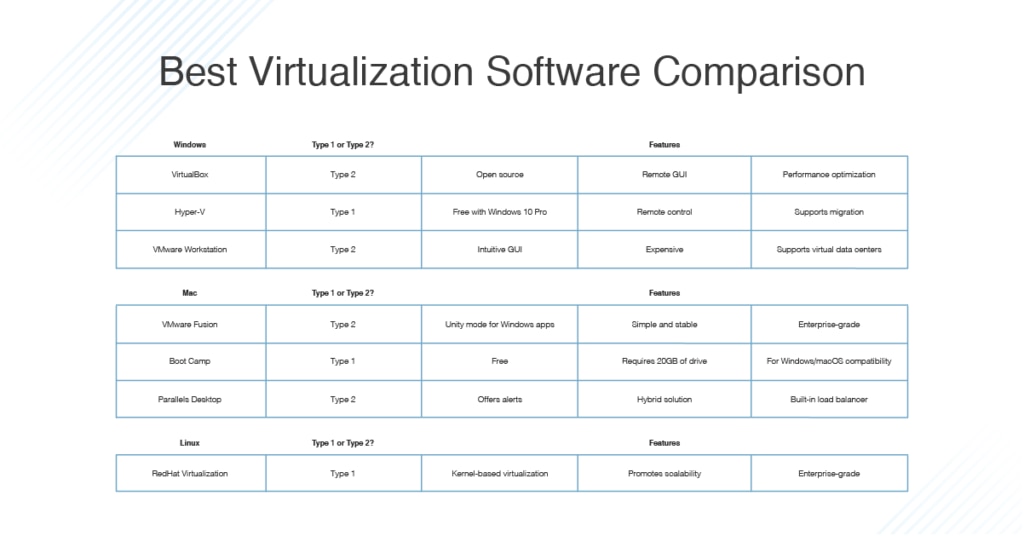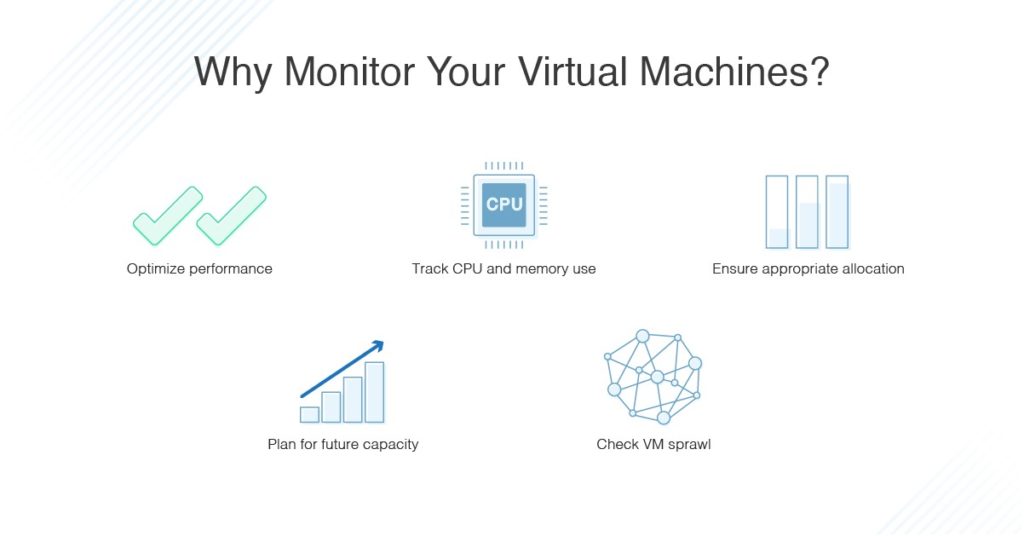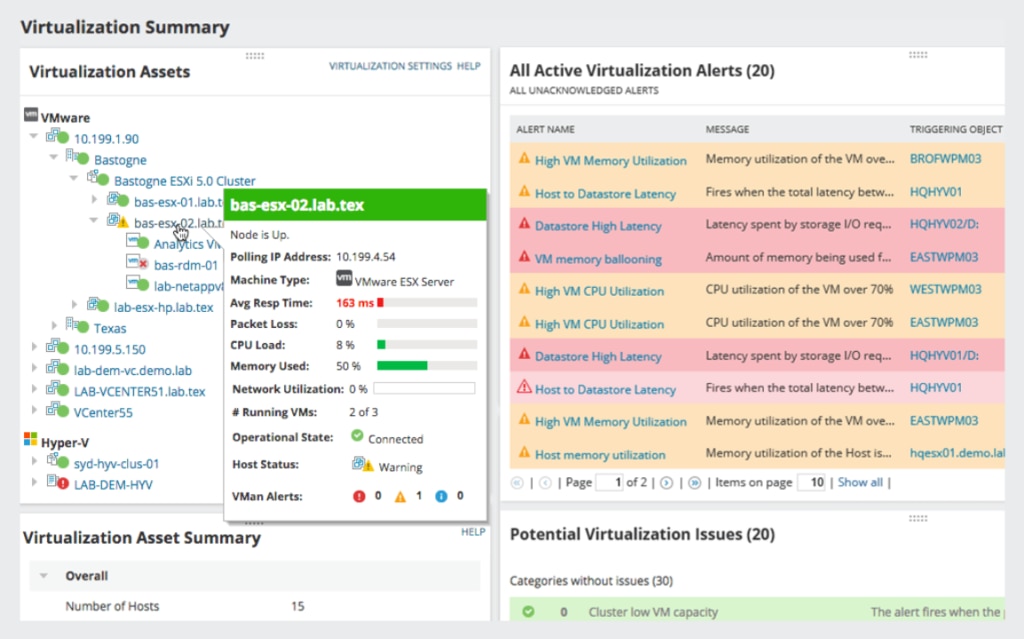Virtualization can be useful everywhere, whether for home office and small business use, or in large enterprises and data centers. Using appropriate software to manage those virtualizations is important—if you aren’t using the right tools, your virtual environment can be messy and ineffective at best, or buggy and non-functional at worst.
In this guide, I’ll provide a quick primer on virtualization, then dive into a virtualization software comparison to determine the top virtualization software on the market for today. In addition, if you’re looking for a way to monitor and manage virtualization software—and get the most out of your virtual environments—I’ll explain why you should consider a tool like SolarWinds® Virtualization Manager.
What Is Virtualization?
What Is Virtualization Software?
Best Virtualization Software Comparison
What to Know about Virtualization Software
Benefits of Monitoring Your Virtual Machines
How to Choose the Best Virtualization Software
What Is Virtualization?
Virtualization comes in many forms and can be applied differently depending on what you’re trying to virtualize. For example, you can virtualize networks, desktops, applications, storage and server infrastructure, and data. I’ll go through the different kinds of virtualization, then look at software to create and manage virtual machines.
- Desktop virtualization. Most people are already familiar with desktop virtualization. This is where instead of an operating system being installed on the physical hardware of a computer, a software layer exists between the hardware and the virtual desktop. This software is called a hypervisor, and can be installed directly on the hardware. You can also install an operating system first (such as Windows), then install the hypervisor on top of the OS. The hypervisor could then, for instance, set up a virtual machine running Linux. This way, you could use Windows on your computer and a Linux virtual machine. This is particularly useful for testing applications on different operating systems or software in development.
- Application virtualization. The next kind of virtualization most people have used is called application virtualization. This is where an application is virtualized and stored on servers external to the physical device you’re using to access the application. You might use this to run a Mac-only application on a Windows device, for instance.
- Network virtualization. Networks can be virtualized by collecting network resources such as switches, routers, and other network infrastructure. The collective abilities of those resources can then be aggregated, and the entire network managed as one entity. If network usage is variable, by virtualizing the network you can then allocate and distribute resources more efficiently and keep performance stable and high.
- Storage virtualization. This is when storage from multiple physical storage devices is combined and treated as one storage device (like network resources above). The virtual storage can then be managed as one storage device, and you can allocate, change, move, and set up resources more flexibly across your infrastructure as needed.
- Server virtualization. When servers are virtualized, a tool splits up the resources of one server into smaller virtual machine servers. This allows users to access each virtual server, and physical resources can be made more efficient. Instead of having three physical servers allocated to three parts of the business, you can split up one physical server into three virtual machines. This can make your server infrastructure more streamlined and save on hardware costs.
- Data virtualization. Data is aggregated across a system and then provided in virtual form to devices in the network or system. Those devices can access virtual data without needing to know exactly where it’s stored, and the original data doesn’t need to be moved or copied for devices throughout the infrastructure to access it.
What Is Virtualization Software?
Virtualization software allows you to create virtual machines for the kinds of virtualization we discussed above. In most cases, you use virtualization software to create virtual networks, virtual desktops, and virtual servers. These pieces of software are called hypervisors or virtual machine monitors.
Hypervisors work by creating an additional layer between your physical hardware (or operating system) and a virtual machine. They can be either “bare metal” hypervisors or “hosted” hypervisors. Bare metal hypervisors are installed on the physical hardware, without any operating system (also called Type 1). You can then create virtual machines directly. Hosted hypervisors (Type 2) run on an existing operating system and are generally easier to operate as they function like any other program you can use on your computer.
Best Virtualization Software Comparison
I’ll go through the different options available on the market, including the best virtualization software for Windows, Mac, and Linux today.

Top 3 Virtualization Software for Windows
- VirtualBox
VirtualBox is free virtualization software for Windows in the form of an open-source hypervisor. Don’t be fooled by it being free: this Oracle product is one of the best Windows virtualization tools out there. VirtualBox can run on host operating systems including Windows, Linux 2.4 and onwards, Server 2003, Solaris, OpenSolaris, and OpenBSD, and can also install these as guest operating systems.
VirtualBox is a hosted hypervisor—this means you run it on your operating system as an application and create virtual machines through this application. VirtualBox uses snapshots to save a current VM state, so you can revert to it later if necessary. Snapshots are primarily used for testing purposes. Finally, it supports the migration of virtual machines, performance optimization tools, and a remote-access GUI. - Hyper-V
Another huge player on the market is the Hyper-V software, a Microsoft virtualization software. This is one of the primary competitors for VirtualBox. While VirtualBox is a hosted hypervisor, Hyper-V is a bare metal hypervisor. When your computer starts up, Hyper-V is running directly from the BIOS, and will start a virtual machine management system such as Windows, Windows Server, or Hyper-V Server. If the computer is running, Hyper-V will be running, while VirtualBox is only started if the user opens the VirtualBox application on their operating system.
While VirtualBox can run on all the operating systems discussed above, Hyper-V is only compatible with Windows. This is one of the main downsides of Hyper-V. If your enterprise uses several different platforms, VirtualBox would be your choice. However, if you have a Windows-only or primarily Windows-based system and you want a bare metal hypervisor, Hyper-V is the front-runner.
Unlike VirtualBox, Hyper-V only supports hardware virtualization, but all its other features are very similar (migration, remote control, etc.) However, support isn’t great, and the software can be a bit clunky to set up and use. On the upside, it comes as free virtualization software with Windows 10 Pro and Windows Server. - VMware Workstation
VMware is another dominant player in the market of virtualization software for Windows, with highly rated products for different host operating systems.
Like VirtualBox, VMware Workstation is a hosted hypervisor, and is installed on the operating system and used like an application. VMware Workstation can only be installed on Windows and Linux machines, but VMware offers VMware Fusion for Mac as an alternative. VMware Workstation can create guest operating systems of Linux, Windows, Solaris, FreeBSD, and macOS. It also supports hardware virtualization but doesn’t provide software virtualization like VirtualBox.
VMware Workstation has a high-quality, intuitive, and easy-to-use GUI. VMware also produces VMware vSphere, a bare-metal hypervisor for Windows systems. Instead of virtual desktops, this is used to create virtual data centers. Think carefully about exactly what you want to use your virtualization software for, as several of these manufacturers have slightly different products for different virtualization needs. VMware products can be expensive.
Virtualization Software for Mac
- VMware Fusion
When it comes to virtualization software for Mac, VMware offers the VMware Fusion tool. It supports basically the same list of hosted machines as VMware Workstation and vSphere. It also includes a “Unity Mode,” which allows you to launch Windows applications from the macOS dock. This way you can integrate the operating systems. The software is visually pleasing, simple to use, and highly stable with a low occurrence of errors.
However, there are some downsides. When compared to booting a Windows OS using VMware, both Parallels and VirtualBox were much faster. VirtualBox sets up fewer functions than Parallels and VMware Fusion, so it makes sense to boot faster. VMware Fusion is generally considered enterprise-grade software, as it sets up more complex integrations and has more features. On the other hand, Parallels is generally used more for home office or small business virtualization.
You can get a free trial of VMware Fusion if you want to test it out before you buy it. There are two different versions: Basic and Pro. - Boot Camp
This is free virtualization software from Apple for creating virtual machines for Macs, created by Microsoft and Apple working together. It allows you to effectively run Windows operating systems on Mac hardware. When you boot up your Mac using Boot Camp, you can choose between Windows or Mac OS, depending on your preference at the time. It has been around since 2007 and allows you to boot either operating system by partitioning the hard drive.
You set up Boot Camp using a tool called the Boot Camp Assistant. By default, it takes around 20GB of your hard drive for your Windows partition and will leave the rest for Mac OS to run. If you know you’re going to be installing large applications on the Windows partition, allocate it more of your hard drive.
- Parallels Desktop
Many Mac users prefer to use Parallels over Boot Camp, as it can integrate more easily with Windows alongside the native Mac OS. It even allows alerts from your Windows virtual machine to show up in your Mac OS alert center, which lets you keep track of what is happening in your VMs even when you aren’t actively using them. Parallels can also create VMs using various Linux distributions, and can run Chrome OS or older versions of Mac OS if you need them for testing purposes.
Best Virtualization Software for Linux
RedHat Virtualization
When it comes to Linux virtualization software, some of the above tools can also be used on Linux operating systems, even though they were designed for Windows or Mac. However, RedHat Virtualization is made specifically for Linux operating systems. It’s easy to use and is based on the KVM (kernel-based virtual machine) hypervisor. Even though it’s a hosted hypervisor, a huge amount of development has gone into the maturity of this software, making it in many cases as fast as a system operating in a non-virtualized way.
It can support guest operating systems of other Linux distributions, Windows 7, 8, 8.1, and 10, and Windows Server distributions. It promotes high levels of scalability and can create large virtual machines to support huge enterprises. You can get free trial of RedHat Virtualization or purchase it on a subscription basis.
What to Know About Virtualization Software
VMware Workstation and other VMware products are generally considered the industry standard and are known as some of the best virtualization software options for both Windows and Mac host operating systems. Overall, the best option for Mac in my opinion is Parallels or VMware Fusion, with the Boot Camp providing basic functionality if you just want to be able to run a Windows OS alongside your Mac OS. Some of the above software can also run on Linux distributions, but the RedHat Virtualization tool is much faster, since it’s specifically designed for use on Red Hat Linux.
However, ultimately you need to choose the best virtualization option for your network and infrastructure setup. All these need monitoring tools to keep an eye on performance, as virtual machines and their accompanying virtual environments come with unique challenges.
Benefits of Monitoring Your Virtual Machines

When you use virtualization software and run virtual machines, you need to ensure you track behavior, capacity, and performance. For this purpose, most enterprises will use virtual machine management tools operating independently of the hypervisor or virtualization software.
Monitoring is important because virtual environments have different challenges from physical environments. A guest machine doesn’t have direct access to the hardware—it goes through a hypervisor or other virtualization software. It’s vital for the hypervisor to function correctly and allocate the appropriate physical resources to your virtual machines as needed. Monitoring CPU and memory use and allocation is important for ensuring VMs perform as expected. In addition, you need to ensure network components and storage are working well, so you don’t run into bandwidth issues or capacity problems affecting your users.
Essentially, physical machines working with physical hardware can only use what the physical hardware has available. Virtual machines can be allocated as much of the physical resources as the administrator wants, meaning a computer with 10GB of RAM could host 10 guest operating systems, and allocate each guest 2GB of RAM, and just hope each OS doesn’t always need to use the full RAM allocation. This “overprovisioning” is common but can cause problems if not managed and monitored correctly.
A good virtual machine monitoring tool should be able to look at the guest OS layer as well as the virtualization layer, to ensure data from both “sides” matches up. The virtual environment should be treated, not one machine at a time, since you need to keep an eye on your entire virtual infrastructure to reduce VM sprawl and scale effectively. Creating too many virtual machines then leaving them to operate unchecked can cause major performance issues if you don’t have a management tool in place.
All the above tasks are easier with the right software. My top pick for a virtualization management tool is SolarWinds Virtualization Manager (VMAN). VMAN provides comprehensive VM monitoring, including capacity planning, VM performance monitoring and management tools, and complete visibility across Hyper-V and VMware virtualization software. It can also provide information on your entire virtual infrastructure, such as host machines, VMs, cluster organization, virtual storage such as vSANs, and performance metrics.

SolarWinds VMAN has built-in tools to help reduce VM sprawl, such as powering off idle VMs and deleting powered-off VMs that haven’t been used in a while. Finally, VMAN has useful prediction tools for keeping track of network and storage needs, CPU and memory functionality, and complete visibility across your entire stack (whether it’s virtual infrastructure, storage, or server). I also like its free 30-day trial, so you can test it out for yourself.
How to Choose the Best Virtualization Software
The virtualization software you choose depends to a large extent on what operating systems your current devices already run and what infrastructure you have set up. It also depends on what level of security you need, whether you want bare metal or hosted hypervisors, and what kinds of operating systems you want to virtualize. As I mentioned above, there are a few big players on the market, but ultimately you need to choose what fits with what your company is trying to do.
In all cases, you need to ensure your virtual machines and accompanying software are functioning correctly and performing well, and for this I recommend using a comprehensive monitoring software. My top choice is SolarWinds Virtualization Manager, because of its ease of use, numerous features, and cost-effective pricing.
